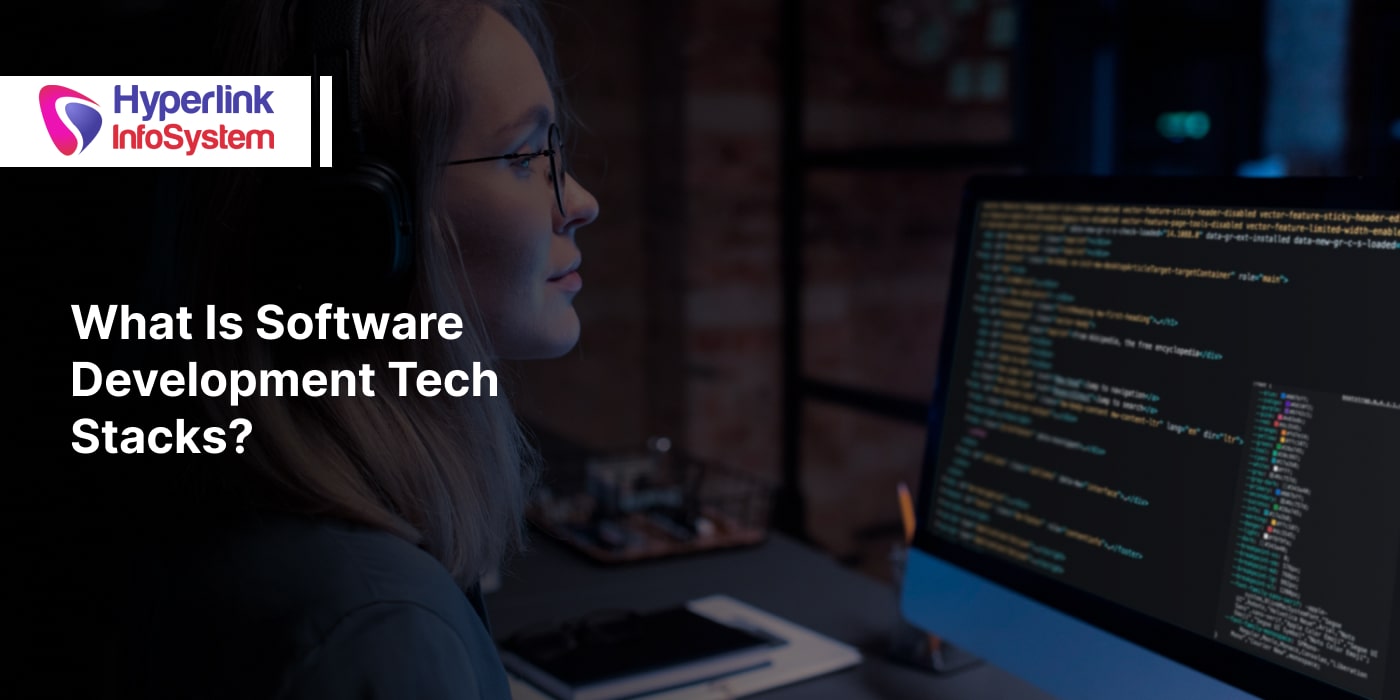Understanding Software Development Tech Stacks and Tips to Choose the Best One
Sep 2024

Imagine you want to submit a painting at any particularly themed painting exhibition. You need to understand the exhibition theme, choose a topic to portray, choose colors, combinations, and whatnot! You need to combine all these pieces to have a great painting! Just like that, when you're planning for a software development project, there are so many pieces you need to get together to solve this great puzzle of a successful app development approach. One of the most important and delicate topics is to choose a software development tech stack.
What Is a Software Development Tech Stack?
A software development tech stack is a set of tools, frameworks, programming languages, and technologies that programmers make use of when developing, running, and maintaining applications. It can be perceived as the repository of various elements for designing a particular software good that are somehow integral in any stage of development.
Components of Software Development Tech Stack
A software development tech stack consists of different parts that come together to make an application that works. Whether it's controlling the user interface of the application or managing data behind the scenes, each component has a defined function. Below is a summary of the essential elements:
- Client-side (Front-end)
This is the part that users interact with and it is about the view of your app or website; it's the face of your application. To spread the magic, developers use technologies like UI frameworks, JavaScript, HTML, and CSS.
- Server-side (Back-end)
It is the brain of the application, this is where the logic makes decisions. It handles requests coming from the front end. Operating systems, servers, web frameworks, and programming languages are part of it.
- Database
It is the app's memory bank, where information about products and user profiles are stored. It functions much like a memory bank and it keeps everything organized.
- Operating System (OS)
It is a silent powerhouse that manages computer hardware to provide efficiency for other software's working. Linux, Windows, and macOS.
- Web Server
It takes care of HTTP requests and shows and loads web pages to users. There are many web servers available, such as Apache HTTP servers and more.
These are the different components and layers that collectively form a software development tech stack and work as the core of any software development project.
Popular Software Development Tech Stacks
Many technology stacks are used by developers vividly. Here are some popular tech stacks to look for in 2024.
- MEAN Stack
MEAN stands for MongoDB, Express.js, Angular.js, and Node.js. It is the most used and reliable technology stack when it comes to dynamic web app development. It is also a budget-friendly option as its components are mostly free and open-source. Developers use MEAN to develop real-time chat applications by using Angular.js. MEAN allows flexibility to transfer the code from one platform to another without impacting the functionalities in full-stack development. One of the noticeable aspects is that it is all Javascript-based only. It is also considered as a scalable tech stack. Some famous applications built using the MEAN stack are PayPal, Upwork, Forbes, etc.
- MERN Stack
Floors such as MongoDB, Express.js, React.js, and Node.js build a strongly founded building of MERN stack. It uses React and JSX so that developers can reuse the components that are similar to each other. With Virtual DOM, developers can easily make changes in real time. Netflix, Facebook, and Discord are built using the MERN stack. As MongoDB works well with Node.js, it allows representation and storing data much easier. As React loads in real-time, it enhances the user experience and provides fast and responsive interfaces. Hire software developers for real-time full-stack development.
- LAMP Stack
LAMP= Linux, Apache, MySQL, PHP/Python/Perl. All these technologies are already open-source and well-managed. It is widely used in content management system (CMS) development, as LAMP provides a stable foundation and capacity to handle and generate dynamic content. All these technologies have large open communities to maintain and update the technologies. This ensures the reliability and security of the software development tech stack. WordPress and Drupal are based on LAMP. Apache servers receive the incoming requests and pass them to PHP components. These components process the requests and return the responses.
- Ruby on Rails Stack
Rails is a web app framework in Ruby under the MIT license. It follows the model view controller (MVC) pattern, so it provides default structures for databases, web services, and pages.
Ruby on Rails = Ruby as a programming language + Rails as a framework.
It is a perfect and dynamic combo for web development. It is helpful and efficient for database setups, migrations, and scaffolding. It is mostly used in content management system development. Airbnb and Shopify are built using ROR.
- .NET Stack
.NET runs smoothly on any operating system. It is an open-source developer platform providing a bundle of tools, languages, and libraries for custom software development. Your .NET code can operate on a variety of operating platforms, including Windows, iOS, Android, and more. Developers prefer .NET for its user-friendly development, code reusability, flexibility, huge support community, and support for high-performance apps. It is mostly used in e-commerce platform development. GoDaddy and BBC Good Food are built using .NET.
- Flutter Stack
Flutter has the capability of developing multi-perform apps from one codebase. It was launched by Google, and it uses Dart as a programming language. It helps in the faster development of apps across the platforms. Flutter has a built-in widget range and UI toolkit, along with Google's Firebase for the backend side. With Flutter, developers can build visually appealing and high-performance mobile apps for both iOS and Android. Apps like Google Pay, Alibaba.com, and Google Ads are built using Flutter.
- Serverless Stack
Developers don't have to worry about managing code infrastructure, they can solely focus on coding. The serverless stack is powered by AWS Lambda, Google Cloud, and Azure functions. It is very cost-effective as it follows the "you only pay for what you use" approach and the FaaS model. It is a streamlined and efficient solution as the cloud provider takes care of the increased traffic.
It is difficult to choose a tech stack for your next software solution. Being a leader in custom software development for over a decade, here we are listing some key points to remember while choosing a software development tech stack.
Read Also: How To Select The Best Tech Stack For Your Healthcare App?
Tips for Choosing Software Development Tech Stack for Software Development
1) Check Time to Market for Software Delivery
It is important to choose the tech stack based on the time to market. If you already have a deadline, then choose a technology stack that matches the deadline. Different tech stacks take different amounts of time to complete the software development. If you are looking to develop a basic application like MVP, then MERN is a good choice, as Javascript makes it more efficient and quick. For a detailed understanding, you should contact a custom software development company.
2) Understand Project Requirements
Firstly, set the goal of your software app development and, based on that, assess the project requirements like target audience, size of software, feature complexity, number of features, security needs, and more. Figure out these aspects and then decide on the tech stack. You'll be able to choose the right technology stack for your software solution if you have all these figured out.
3) Check What’s in Your Budget
Well, different tech stacks are made of different types of tools and technologies. Some of them are free and some are not! If you already have a budget in mind, then share it with your app development partner. They will guide you about the best tech stack that fits your budget and matches other requirements too.
4) Understand the Future Scope and Scalability
When you're choosing a tech stack, it becomes crucial that you set the future goals for the project too at an early stage only because some technologies may not support your project's future scope and won't allow future expansion. Choose a tech stack that supports future expansion.
5) Evaluate Team Expertise
It is not easy to hire software developers, especially when you have a large pool of developers to choose from. Start with choosing a top custom software development company. Check their past work, client testimonials, experience, and expertise as developers. Talk with them and understand their project development approach and assess their communication too. Make sure that they follow all the security guidelines too.
Benefits of Selecting the Right Tech Stack
Many benefits come along with choosing the right tech stack for your project, such as:
- Optimized App's Performance
These worries about the applicability and reliability of the application are gone when you design and build it using relevant technologies. It may successfully respond to multiple requests concurrently, accommodate a growing client community, as well as handle a range of concurrent tasks. The best performance comes with the right tech stack.
- Keeps It All Within Budget
The right tech stack saves you from unnecessary effort and steps. Tech teams may stick to their development budget and reduce expenses associated with needless delays in development thanks to this. Moreover, tech teams can save money on maintenance by using tech stack optimization to guarantee that the program operates at its best and has fewer errors or problems while also running more smoothly.
- Better App Management
A comprehensive infrastructure that guarantees smooth operation is provided by the correct tech stack, which streamlines the development process. The technical team has more substantial control over the entire development process and can more easily manage and coordinate development tasks.
Conclusion
By now, we have covered all the important aspects to consider when choosing a tech stack for software development. In this respect, it is important to think about project requirements, time-to-market, cost, application complexity, future scope, and scalability. As a leading custom software development company, we understand the ROI of any software project. We follow the software development process which states that every single part of the project must be properly defined and understood by all members of the team.
Let us know if you need any assistance in deciding which software development technology stack is best for your particular purposes. We can support you in choosing the right tech stack from a range that already exists.
Frequently Asked Questions
Operating systems, databases, servers, programming languages, testing frameworks, front-end and back-end tools, and numerous other tools, technologies, libraries, and frameworks are all included in a tech stack.
The main difference between MEAN stack and MERN stack is that MEAN uses Angular JS whereas MERN uses React JS.
Yes, you can. But moving a project from one tech stack to another can be expensive, long, and effort-taking. This is why we suggest choosing the right tech stack from the beginning only.
Latest Blogs

Is BlockChain Technology Worth The H ...
Unfolds The Revolutionary & Versatility Of Blockchain Technology ...


IoT Technology - A Future In Making ...
Everything You Need To Know About IoT Technology ...

Feel Free to Contact Us!
We would be happy to hear from you, please fill in the form below or mail us your requirements on info@hyperlinkinfosystem.com
Hyperlink InfoSystem Bring Transformation For Global Businesses
Starting from listening to your business problems to delivering accurate solutions; we make sure to follow industry-specific standards and combine them with our technical knowledge, development expertise, and extensive research.
4500+
Apps Developed
1200+
Developers
2200+
Websites Designed
140+
Games Developed
120+
AI & IoT Solutions
2700+
Happy Clients
120+
Salesforce Solutions

40+
Data Science

















